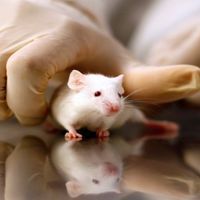Login
Subscribeanimal models

Stem Cell Transplant Treats Parkinson’s Disease in Monkeys
Roni Dengler, PhD | Feb 7, 2022 | 4 min read
Personalized stem cells improved motor symptoms and depression signs in monkeys modeling Parkinson’s disease, paving the way for trials in human patients.

A New Model with Fully Functioning Blood Vessels Mimics Brain Cancer
Roni Dengler, PhD | Sep 10, 2021 | 2 min read
A newly developed platform may one day replace cell culture and animal models to personalize cancer treatment.

A Ticking Time Bomb: Tracing the Origin and Spread of SARS-CoV-2
The Scientist | 1 min read
Linda Saif will give a historical overview of SARS spillovers from animals to humans, and Neville Sanjana will describe recent work on a SARS-CoV-2 spike protein variant that increases human infectivity.

“Lemon Frost” Leopard Geckos’ Cancers Similar to Human Melanomas
Christie Wilcox, PhD | Jun 24, 2021 | 6 min read
The color morph’s bright yellow hue and its propensity for skin tumors both likely stem from a gene implicated in a dangerous form of human skin cancer, suggesting the animals could make an ideal model for studying the disease.

The Many Model Systems of COVID-19
Abby Olena, PhD | Nov 4, 2020 | 7 min read
Researchers turn to familiar model animals, along with some fresh strategies, to develop countermeasures against SARS-CoV-2 and investigate the biology of infection.

Michelle Gray Tracks Huntington’s in Different Brain Cells
Amanda Heidt | Oct 1, 2020 | 3 min read
The University of Alabama at Birmingham neuroscientist aims to determine which cells are most important in prompting the disease’s initiation and progression.

Blood Replacement Rescues Mice from Stroke Damage
Amanda Heidt | Aug 31, 2020 | 5 min read
When mice that had suffered a stroke were given blood from a healthy donor, they experienced less tissue and neurological damage.

Noel Rose, Who Demonstrated Autoimmunity Exists, Dies at 92
Amanda Heidt | Aug 10, 2020 | 4 min read
The Johns Hopkins University researcher bucked the prevailing idea that the body would not launch an immune response against its own tissues, and in doing so established an entirely new scientific discipline.

Image of the Day: Biomimetic Arteries
Amy Schleunes | Apr 6, 2020 | 1 min read
A newly engineered synthetic blood vessel offers a novel platform for developing drugs that treat high blood pressure.

Cells’ Response to SARS-CoV-2 Different from Flu, RSV
Abby Olena, PhD | Mar 31, 2020 | 4 min read
The host transcriptional signature elicited by the coronavirus appears to be less robust and lacks the induction of key antiviral genes.

Animal Facilities Make Tough Decisions as Pandemic Closes Labs
Abby Olena, PhD | Mar 27, 2020 | 4 min read
Many researchers have stopped breeding mice, reduced the size of colonies, and established contingency plans in case animal care staff get sick.

US Primate Centers Work to Protect Animals from COVID-19
Ashley Yeager | Mar 19, 2020 | 4 min read
Rhesus macaques can be infected with SARS-CoV-2, leading primate center scientists to try to prevent outbreaks in their colonies, especially as experiments on coronavirus start.

Rabbit Study May Hint at Origin of Female Orgasm in Humans
Catherine Offord | Oct 1, 2019 | 2 min read
It could be a throwback to a mechanism that induces ovulation during sex, researchers propose, but not everyone thinks the results can be extrapolated to people.

Image of the Day: Seizure Proteins
Nicoletta Lanese | Aug 14, 2019 | 1 min read
The sei ion channel in fruit flies keeps their neuronal excitability in check.

Mouse Model Shows How Parkinson’s Disease Begins in the Gut
Emma Yasinski | Jun 26, 2019 | 3 min read
Johns Hopkins’s Ted Dawson discusses his lab’s demonstration that misfolded α-synuclein can move from the stomach to the brain and cause physical and cognitive symptoms.

Wellcome Sanger Institute to Close Animal Facility
Chia-Yi Hou | Jun 10, 2019 | 1 min read
The move reflects scientists using more cell lines and organoids in genetic research, although some experts disagree with the decision to scale back the use of animal models.

Opinion: AI Beats Animal Testing at Finding Toxic Chemicals
Thomas Hartung | May 1, 2019 | 3 min read
Machine learning could be the key to reducing the use of animals in experiments.

Swiss Researchers Struggle to Get Animal Experiments Approved
Diana Kwon | Jan 8, 2019 | 6 min read
Scientists say that increasingly rigorous licensing procedures have complicated research efforts—and in some cases, stopped experiments completely.

Lab Animal Use in the UK Dips Below 2010 Levels
Katarina Zimmer | Jul 27, 2018 | 3 min read
A report finds a decline in the number of experiments involving animals in 2017, noting a particular decrease in procedures on dogs and primates.
